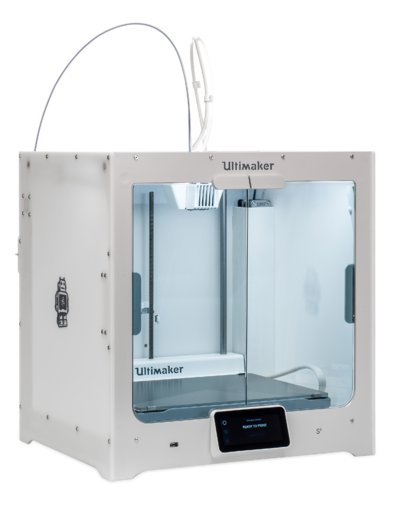Ultimaker S5: Difference between revisions
No edit summary |
No edit summary |
||
| Line 8: | Line 8: | ||
The Ultimaker's base software for creating images to be printed is [[#About Cura | Cura]]. | The Ultimaker's base software for creating images to be printed is [[#About Cura | Cura]]. | ||
As we only have one printer, the Ultimaker is run in a first-come-first-serve basis. This means that there is no queue to get in line for having your print started. The only way to '''ensure''' that you get your print done is to be at the printer when another print finishes and start your print then. The best we can do to help you if you talk to one of the managers is if they know how to work the printer they can start your print at the end of the current one if they would still be present. '''This is not a guarantee.''' Managers reserve the right to restart or cancel prints if they look misconfigured (like forgetting support) or is failing. | As we only have one printer, the Ultimaker is run in a first-come-first-serve basis. This means that there is no queue to get in line for having your print started. The only way to '''ensure''' that you get your print done is to be at the printer when another print finishes and start your print then. The best we can do to help you if you talk to one of the managers is if they know how to work the printer they can start your print at the end of the current one if they would still be present. '''This is not a guarantee.''' Managers reserve the right to restart or cancel prints if they look misconfigured (like forgetting support) or is failing. If a print is failing because it needs support and wasn't set properly, we will cancel it and not be able to restart it because the ultimaker needs an updated Gcode file which we cannot create without knowing the specifics of your print. | ||
== About Cura == | == About Cura == | ||
Revision as of 22:14, 5 December 2019
Overview
The Ultimaker S5 is a high-end FDM (fused deposition modeling) 3D printer with dual extruders.
Fusion Deposition Modeling works by placing layers of melted material in a certain path over and over. Soon after the material is placed down, it hardens, allowing the next layer to be placed and stick on top. The path is determined by slicing an object and splitting it up into predetermined sized layers based on a setting in the editing software.
The Ultimaker's base software for creating images to be printed is Cura.
As we only have one printer, the Ultimaker is run in a first-come-first-serve basis. This means that there is no queue to get in line for having your print started. The only way to ensure that you get your print done is to be at the printer when another print finishes and start your print then. The best we can do to help you if you talk to one of the managers is if they know how to work the printer they can start your print at the end of the current one if they would still be present. This is not a guarantee. Managers reserve the right to restart or cancel prints if they look misconfigured (like forgetting support) or is failing. If a print is failing because it needs support and wasn't set properly, we will cancel it and not be able to restart it because the ultimaker needs an updated Gcode file which we cannot create without knowing the specifics of your print.
About Cura
- Cura can be found for free on Ultimaker's website: Cura Download
- More Cura Help
- Cura allows 3D file formats: 3MF, OBJ, STL or 2D file formats: bmp, gif, jpg, png.
- You can download Cura and prepare a print on you own computer and load it onto a flash drive for the Ultimaker
- Possible ways of getting objects to print:
- Finding and downloaded STL files from Thingiverse
- Create your own CAD files using a program like Solidworks, Siemens NX, Autodesk, or anything that will create the accepted file formats.
Choosing a Material
Each material that can be printed with have certain characteristics that allow them to be more desired than others in certain situations. Examples of qualities would be strength against breaking, temperature resistance, quality, ease, flexibility, and many more.
The Ultimaker S5 nozzle can reach temperatures up to 280 degrees Celsius and the heated bed can reach temperatures up to 140 degrees Celsius. Materials must have a melting point under 280 degrees Celsius.
| Material Type | Advantages | Disadvantages |
|---|---|---|
| PLA (Polyactic Acid) |
|
|
| ABS (Acrylonitrile Butadiene Styrene) |
|
|
| Nylon (Polyamide) |
|
|
| PETG (Polyethylene Terephthalate, Glycol Modified) |
|
|
| TPU (Flexible) |
|
|
